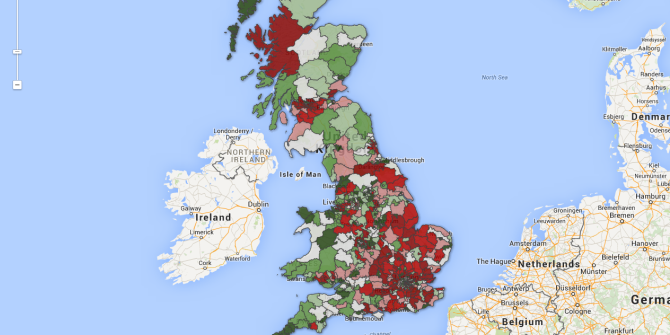With the rise of UKIP rightly garnering much attention, it is perhaps understandable that another small party who have seen their poll rating grow have been the subject of less press coverage and discussion. Here, Ian Warren (aka @election_data) shows that the Greens are performing strongly amongst certain demographics, and may well have an impact on the 2015 General Election.
There has been understandable attention paid to the emergence of UKIP as a major factor in 2015. However comparatively little attention has been paid to the Green Party. Typically when I mention the Green Party to politico’s there’s a palpable shrug of the shoulders and a sigh, as if it’s somehow beneath them. I’m a cold fish, so a party taking 6% in national polling, in my view, is at least worthy of analysis. I want to make it clear that I am relatively new to Green politics so if some of the points raised here seem naive it’s because they probably are! Go easy on me.
I will start with the polls. Depending on which pollster you believe the Greens are capturing around 5% in voting intention polling. Looking through the crosstabs you find that around 10% of Lib Dems are intending to vote for the Greens in 2015. Their support is strongest among 18 to 24 year olds, around 12% of whom say they are intending to vote Green.
However national voting intention polling tells us comparatively little about the differential impact the party will have in 2015. Clearly there are some seats where the party either has a strong political base and good demographics, seats where they should expect to poll higher than the 5% recorded in VI polls. Seats like Brighton Pavilion or Manchester Withington, for example. Lord Ashcroft’s poll of Lib Dem-Labour marginals had the Greens at 20% in Norwich South and 32% in Brighton Pavilion, the latter of which surprised me a little given the apparent unpopularity of the council in Brighton.
In terms of areas of the country where the party has a strong political base and a relatively good recent record in local and European elections there is a comparatively long list of successes for a party which claims so little attention in the national media spotlight. The maps below shows their vote share record in the 2014 European elections (I am including the Scottish Greens although I know they are a separate entity to the Green Party of England & Wales):
The party performed strongly across the south east, London, and south west and up into East Anglia. In terms of vote share the party achieved 6.9% of the popular vote and won three MEPs as a result (one each in London, the south west and south east). In local authorities like Brighton & Hove, Norwich, Oxford, Cambridge, Bristol, South Hackney, Hams, Stroud, Bath, York, Haringey and Lambeth the party performed much better than its national vote share.
As Patrick O’Flynn has pointed out, the Greens could eat into Lib-Lab contests in places like Cambridge:
Interesting that Greens are scoring a visible poll rating these days. I think they'll eat into Lib/Lab vote in places like Cambridge 😉
— Patrick O'Flynn (@oflynnsocial) August 14, 2014
Of course Mr O’Flynn would say that, given that he has announced his intention to put his name forward as the UKIP candidate in the seat. However the recent local elections in the seat point to a pronounced uptick in support for Labour from 2010. Labour’s vote share in the Cambridge local elections was up 16% on 2010. In fact even the Greens saw a slight vote share dip of 1.3% from 2010 to 2014. The two biggest losers in Cambridge were the coalition partners. The Lib Dems saw their vote share drop from 37.8% in 2010 to a still respectable 29%, whilst the Conservatives saw their vote share fall from 22.5% in 2010 and 14.4% in 2014. UKIP stood just three candidates in the Cambridge local elections, polling 0.4% in total.
Making projections based on local and European elections is dangerous given the relative turnout in those elections compared to a general election. Rather it would be more appropriate to consider which demographic groups voted for the Greens in the May 2014 local elections and to then identify seats where such demographic groups account for a higher proportion of such groups.
My analysis has shown that the following demographic groups voted for the Greens in 2014:
- Well educated singles living in purpose built flats
- City dwellers owning houses in older neighbourhoods
- Singles and sharers occupying converted Victorian houses
- Young professional families settling in better quality older terraces
- Diverse communities of well-educated singles living in smart, small flats
- Owners in smart purpose built flats in prestige locations, many newly built
- Students and other transient singles in multi-let houses
- Young renters in flats with a cosmopolitan mix
However the Greens are in a fight with the other parties for these voters come the general election. The key for the party is to identify those seats where these groups account for very large proportions of total households. A list of the top ten seats with such demographics is:
- Cardiff Central (41.1% of households) – 13% LibDem majority
- Sheffield Central (39.7% of households) – Lab majority of 0.4% over Lib Dems
- Bristol West (37.6% of households) – 21% Lib Dem majority over Lab
- Brighton Pavilion (36.7% of households) – Green-held
- Manchester Withington (33.9% of households) – Lib Dem majority of 4.1% over Lab
- Wimbledon (33.6% of households) – 24% Con majority over Lib Dems
- Newcastle-upon-Tyne East (30.6% of households) – 12% Lab majority over LibDems
- Tooting (30.6% of households) – 5% Lab majority over Con
- York Central (29.5% of households) – 14% Lab majority over LD/Con
- Hove (28.7% of households) – 3.7% Con majority over Lab
In many of these seats the Green Party can reasonably expect to increase its vote share, with the possible exception of Brighton Pavilion where one can plausibly make the case that every percentage point of Green support was maximised to the full in 2010. The assumption at this stage must be that the Lib Dems will lose many voters from 2010, and a good proportion of them have shown in the local and European elections that they are not averse to voting for the Greens.
The challenge for the Greens is to retain those voters in 2015. If the polls are to be believed then 10% of 2010 Lib Dems have already decided to vote for the Greens in 2015. If these intentions do convert to votes it will hardly shake the political landscape, but it is at least worthy of some attention.
Note: This article was originally appeared on the Election Data blog and gives the views of the author, and not the position of the British Politics and Policy blog, nor of the London School of Economics. Please read our comments policy before posting. Featured image credit: Christopher Brown CC BY 2.0
Ian Warren is is a political consultant and data analyst with an interest in elections, data analytics and statistics. He blogs at Election Data and his Twitter account can be found here.









@Pension60 because the media doesn’t give them a voice. The Green Party is about to overtake UKIP in terms of membership across the UK, perhaps that should rightly be reported by the main media sources, not just on news 24 but their main news slots. They may not have the voters yet but they are growing into a much larger party than UKIP. It’s now only a matter of time.
Re: My analysis has shown that the following demographic groups voted for the Greens in 2014:
Well educated singles living in purpose built flats
City dwellers owning houses in older neighbourhoods
Singles and sharers occupying converted Victorian houses
Young professional families settling in better quality older terraces
Diverse communities of well-educated singles living in smart, small flats
Owners in smart purpose built flats in prestige locations, many newly built
Students and other transient singles in multi-let houses
Young renters in flats with a cosmopolitan mix
All the parties are fighting for the middle class and above vote, missing the nearly half the population that is the poor, where voting is a matter of life or death.
The 2015 manifesto pledge of The Greens is the sole and unique policy that ends the remorseless rise of starvation since 2010, with the bulk of those going to food banks being those in work, which is:
– universal Citizen Income, non-withdrawable.
The Greens also have the sole policy for a Bettered State Pension that leaves none with no state pension for life, as is being done for women born from 1953 and men born from 1951 with the flat rate pension, that is not more but far, far less or absolutely nil food money for life.
https://you.38degrees.org.uk/petitions/state-pension-at-60-now
Why are The Greens not shouting these policies from the rooftops and gain all these poorest voters, of all ages, who are on wages stagnated a decade into the past, unable to afford energy bills that have for them had an inflation of nearly 70 per cent and barely able to afford to eat on far more inflation on food prices for us.
The Greens could actually win by-elections and the general election in 2015, if they broke free from trying to gain votes from exactly the same voters as all other parties.
I have to say, I agree with Scott. It’s policies such as renationalisation of the railways, the living wage and the protection of the NHS which chime with public opinion and perhaps scares the media establishment into muting the Green Voice (The minority-led Brighton LA being the exception of course: gleefully brought up by any and all interviewers whether relevent or not.)
You’re right though – there are areas where the Green vote is strong: Norwich, Solihull, Bristol etc, and the Green Party would do well to focus it’s attention there.
This is a welcome piece of analysis. My criticism would be the buzzwords attached to being a Green voter. When you lump together phrases like “Cambridge, well-educated, quality older terraces, prestige locations,” it gives a certain impression. Those phrases don’t explain why we’re now the opposition in Liverpool and Solihull, particularly our six seats in north Solihull (working class council housing and tower blocks). But if you look at our emphasis on the living wage, on public services, on renationalisation, and on being great local campaigners, it starts to explain results like Leamington Spa in the 2013 county council elections (winning over Labour with over 60% of the vote, in the most deprived division in Warwick District).